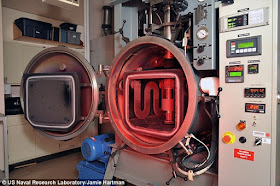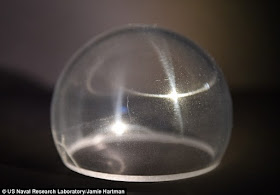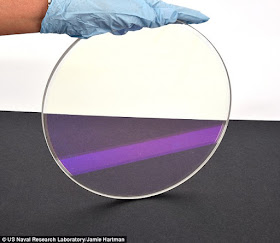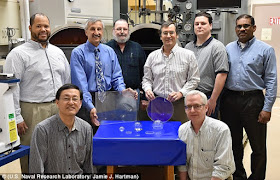Smart Glass Pad and ET Tech Disclosure? Your Next Smartphone Screen Could be BULLETPROOF
(Stillness in the Storm Editor) The Secret Space Program insider and whistleblower Corey Goode claims that within ultra-secret black budget projects are a host of incredibly advanced technology, one of which are what Goode calls Smart Glass Pads. These are iPad-like devices made of a transparent aluminum of incredible strength, which the following article seems to suggest is real. Other whistleblowers have also come forward, such as Pete Peterson, stating that this transparent material is apparently very useful and has been found in ancient ruins all over the solar system.
While this might seem like some obscure fantasy concocted by imaginative ufologists, the following article features a glass-like bullet-proof material made by the US military, lending credence to what is claimed.
According to insiders, a similar material was used by ancient extraterrestrials to build large dome-like structures on the surfaces of moons and planets, providing a protective barrier against harsh conditions. Was the material described in the article below developed by the military by reverse engineering materials from ancient ET sites?
Consider the fourth Star Trek film, Journey Home. In the movie, the crew goes back in time to the mid-'80s for an important mission to rescue humpback whales. Scotty, the engineer, reveals an advanced technology to the locals, transparent aluminum, that is much stronger than the materials available.
Is this just a random coincidence? Likely not. Look at another technology developed recently:
If one were to cross-examine popular media and advances in technology, especially in the highly classified world of unacknowledged special access programs (secret government projects), then it would become clear that a disclosure through fiction campaign has been underway for decades.
What reason would there be to reveal this to the public in this way? This is a large discussion, and I suggest you review the following related article.
For now, consider another piece of testimony by Goode: the powers that be are slowly preparing humanity for an eventual disclosure of highly advanced technology and hidden information in an effort to remake society into a technological transhumanist totalitarian world. He terms this the partial disclosure agenda.
The following article about bulletproof glass could be a piece of partial disclosure propaganda, designed to sell the idea to the public.
But other factions within these secretive groups want to end the system of domination, reveal the whole truth to the people, and release all hidden technologies in an open-source way.
Whether or not all of this sounds like fantasy to you isn't as important as honestly considering the facts.
Society is changing, and it isn't random. The better we're able to recognize these changes and adapt to them, ideally in a moral and ethical way, the better world we can make for our loved ones and ourselves.
- Justin
Source - Daily Mail
Your next smartphone screen could be BULLETPROOF: Scientists create tough see-through 'glass' made from metal
by Richard Gray, April 30th, 2017
- US Navy scientists have developed a see-through armour made from spinel
- Spinel is a mineral made from magnesium aluminate that occurs naturally
- Researchers say it is tougher and lighter than current bulletproof glass
- It could be used to protect military vehicles but could find uses on spacecraft, satellites, cameras and even on smartphones and watches
A transparent metallic 'clay' has been developed by US military scientists that could lead to new super-tough screens and displays.
The material, made from a magnesium and aluminium-based mineral called spinel, is far tougher and lighter than bulletproof glass.
And the researchers claim it could be used to protect vehicles and cockpits on aircraft as well as in spacecraft and satellites.
Some have compared the material to the transparent aluminium used to create the windows on the spaceships in the hit TV series Star Trek.
But the scientists claim it could also be used to create scratchproof lenses for cameras and smartphones whose screens that do not smash when dropped.
They say the transparent armour could additionally find uses in military lasers and infrared equipment.
The material, which has taken more than ten years to develop, is created by pressing a nanopowder together while heating it to create a pure piece of spinel crystal.
This can then be modelled, in a similar way to traditional clay.
Dr Jas Sanghera, who led the research at the US Naval Research Laboratory in Washington, said the material performed far better than bulletproof glass, which works by creating layers of plastic and glass up to five inches thick that slow the passage of a bullet.
He said: 'If you replaced that with spinel, you'd reduce the weight by a factor of two or more.'
The crystal structure of glass means that once a crack forms on the surface, it passes all the way through, and as a result bulletproof glass can become impossible to see through.
Instead, windows made from spinel would not suffer the same problem.
Dr Sanghera said: 'It's like navigating through the asteroid belt, you create a tortuous path.
'If I have all these crystals packed together, the crack gets deflected at the hard crystals. You dissipate the crack energy.'
He added that it could also be used to create new watch faces and smartphones that are truly resistant to smashing.
Spinel, which is also known as magnesium aluminate, can be found naturally occurring as a gemstone, such as the Black Prince's Ruby, which is a coloured piece of spinel.
 |
| The team behind the new material (shown above) have spent nearly a decade developing the techniques. |
However, researchers at the US Naval Research Laboratory have synthesised their own ultra-pure spinel powder which they can form into sheets of crystal using a process called 'sintering' in a hot press.
The material has also been found to be optically very pure and so it can be used to create lenses for sensitive infrared cameras and lasers.
Dr Sanghera said: 'Lasers can be thought of as a box comprised of optics. There's passive and there's active components: passive is just a protective window; active is where we change the colour of light coming out the other end.
'That (passive) window, if it's got any impurities or junk, it can absorb that laser light. When it absorbs, things heat up.'
You need to be a member of Ashtar Command - Spiritual Community to add comments!







Replies